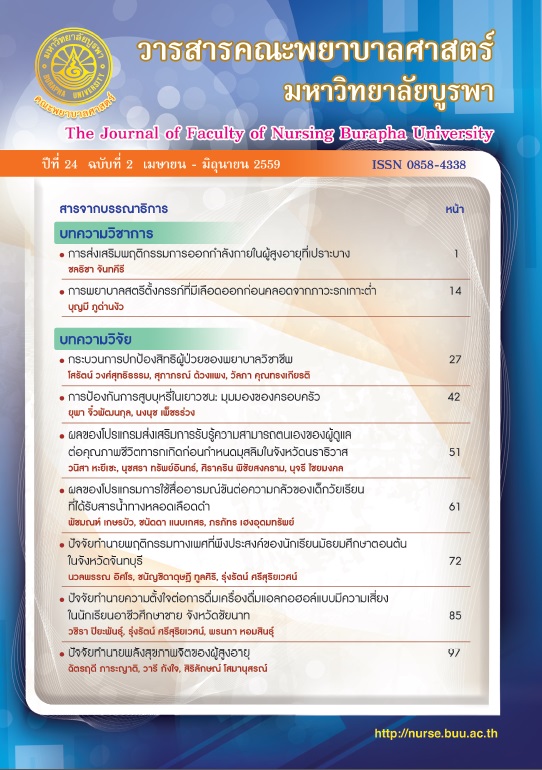ปัจจัยทำนายความตั้งใจต่อการดื่มเครื่องดื่มแอลกอฮอล์แบบมีความเสี่ยง ในนักเรียนอาชีวศึกษาชาย จังหวัดชัยนาท * Predictive Factors of Intention to Engage in Risky Drinking among Male Vocational students in Chai Nat province.
คำสำคัญ:
ความตั้งใจ, ดื่มแบบมีความเสี่ยง, นักเรียนอาชีวะชาย, Intention, risky drinking, male vocational studentsบทคัดย่อ
การศึกษานี้เป็นการหาความสัมพันธ์เชิงทำนาย มี
วัตถุประสงค์เพื่อศึกษาระดับความตั้งใจต่อการดื่มเครื่องดื่ม
แอลกอฮอล์และปัจจัยทำนายความตั้งใจต่อการดื่ม
เครื่องดื่มแอลกอฮอล์แบบมีความเสี่ยงในนักเรียน
อาชีวศึกษาชาย โดยใช้ทฤษฎีพฤติกรรมตามแผน (Ajzen,
1991) เป็นกรอบแนวคิดในการศึกษา กลุ่มตัวอย่างเป็น
นักเรียนอาชีวศึกษาชายระดับประกาศนียบัตรวิชาชีพ
(ปวช.) ชั้นปีที่ 1-3 ในจังหวัดชัยนาท จำนวน 240 คน
ได้มาโดยการสุ่มตัวอย่างแบบหลายขั้นตอน เครื่องมือที่ใช้
เป็นแบบสอบถามตอบด้วยตนเอง วิเคราะห์ข้อมูลสถิติเชิง
พรรณนา และสถิติวิเคราะห์ถดถอยพหุคูณแบบขั้นตอน
ผลการศึกษาพบว่า กลุ่มตัวอย่างมีระดับความตั้งใจ
ต่อการดื่มเครื่องดื่มแอลกอฮอล์แบบมีความเสี่ยงในระดับ
ต่ำ เจตคติต่อการดื่มเครื่องดื่มแอลกอฮอล์แบบมีความเสี่ยง
(β = .294) การคล้อยตามกลุ่มอ้างอิงในการดื่มเครื่องดื่ม
แอลกอฮอล์แบบมีความเสี่ยง (β = .259) ความมั่นใจใน
การปฏิเสธการดื่มเครื่องดื่มแอลกอฮอล์แบบมีความเสี่ยง
(β = - .226) และเกรดเฉลี่ยการเรียน (β = - .161) สามารถ
ร่วมกันทำนายความแปรปรวนของความตั้งใจดื่มเครื่องดื่ม
แอลกอฮอล์แบบมีความเสี่ยงได้ร้อยละ 39.6 อย่างมี
นัยสำคัญทางสถิติ (R2 adj = .396, F(4, 235) = 40.108,
p < .001) ดังนั้น ในการลดความตั้งใจของวัยรุ่นชายในการ
ดื่มเครื่องดื่มแอลกอฮอล์แบบมีความเสี่ยงควรเน้นกลวิธี
ในการปรับเปลี่ยนค่านิยมและความเชื่อที่ผิดๆ ต่อการดื่ม
แบบมีความเสี่ยง รวมทั้งการพัฒนาทักษะการสื่อสาร การ
แก้ปัญหา และการตัดสินใจท่ามกลางแรงกดดันจากเพื่อน
และสังคมรอบด้าน
-----------------------------------------------
The purpose of this predictive correlational
study was to explore level of intention to engage
in risky drinking and examine predicting factors of
intention to engage in risky drinking among male
vocational students. The Theory of Planed Behavior
[TPB] (Ajzen, 1991) was used as a conceptual
framework in this study. Participants were 240
male diploma 1-3 vocational students in Chai Nat
Province. They were selected by multi-stage
random sampling. Data were collected with
self-administered questionnaires. Statistics
including descriptive statistics and stepwise
multiple regression analysis were used for data
analysis.
Results revealed that the sample reported
low level of intention to risky drinking. Regression
analysis demonstrated the TPB explained 39.6%
of the variance in risky drinking intentions of
students, with attitude (β = .294); subjective norms
(β = .259); alcohol drinking refusal self-efficacy
(β= - .226) and grade point average (β = - .161)
making a significant contribution (R2
adj = .396,p < .001). The results suggest that to reduce
intention to risky drinking among male vocational
students should address supporting values and
beliefs against risky drinking and developing skills
in assertiveness, communication, problem solving,
and decision making that were resistant to peer,
social, and cultural pressure.





